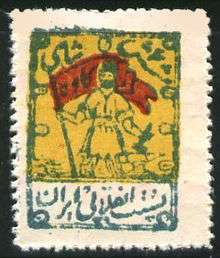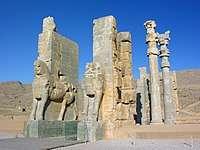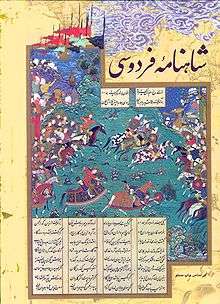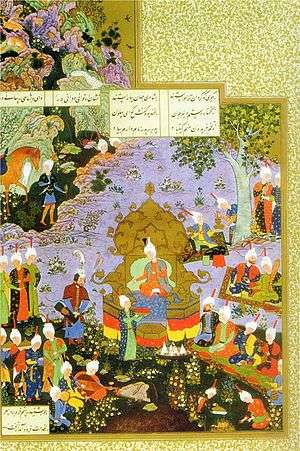Kāve
Kaveh the Blacksmith (Persian: کاوه آهنگر – Kāve ye Āhangar; Kurdish: Kaway Asngar), also known as Kawa or the Blacksmith of Isfahan,[1][2] is a mythical figure in the Iranian mythology who leads a popular uprising against a ruthless foreign ruler, Zahāk (Aži Dahāk). His story is narrated in the Shahnameh, the national epic of Iran, by the 10th-century Persian poet Ferdowsi.
Kāveh was, according to ancient legends, a blacksmith who launched a national uprising against the evil foreign tyrant Zahāk, after losing two of his children to serpents of Zahāk. Kāveh expelled the foreigners and re-established the rule of Iranians.[3] Many followed Kāveh to the Alborz Mountains in Damāvand, where Fereydun, son of Ābtin and Faranak was living. Then a young man, Fereydun agreed to lead the people against Zahāk. Zahāk had already left his capital, which fell to Fereydun's troops with small resistance. Fereydun released all of Zahāk’s prisoners.
Kāveh is the most famous of Persian mythological characters in resistance against despotic foreign rule in Iran. As a symbol of resistance and unity, he raised his leather apron on a spear, known as the Derafsh Kaviani. This flag, known as Derafsh Kaviani, was later decorated with precious jewels and became the symbol of Persian sovereignty for hundreds of years, until captured and destroyed by the Arabs, following the defeat of the Sassanids at the Battle of al-Qādisiyyah. Ya'qub ibn al-Layth al-Saffar, who rebelled against the Abbasid Caliphate, claimed the inheritance of the kings of Persia and sought "to revive their glory," in 867 he sent a poem written by himself to the Abbasid caliph Al-Mu'tazz, stating: "With me is the Derafsh Kaviani, through which I hope to rule the nations."[4]. In later times, Kaveh the Blacksmith was invoked by Persian nationalists starting from the generation of Mirza Fatali Akhundov.[5] His name was used as the title of a nationalist newspaper in 1916,[5] and in 1920, adorned the canton of the flag of the Persian Socialist Soviet Republic (widely known as the Soviet Republic of Gilan).[6]
Mehregan is the celebration for Fereydun's victory over Zahāk; it is also the time when autumn rains begin to fall.
The dynasty of Karen Pahlav (also known as the House of Karen) claimed to be Kāveh's descendants.

See also
References
- ↑ E. W. West (30 June 2004). Sad Dar. Kessinger Publishing. p. 50. ISBN 978-1-4191-4578-0. Retrieved 8 September 2012.
- ↑ Sir John Malcolm (1829). The History of Persia: From the Most Early Period to the Present Time. Murray. p. 13. Retrieved 8 September 2012.
- ↑ Afshin Marashi (1 March 2008). Nationalizing Iran: Culture, Power, and the State, 1870-1940. University of Washington Press. p. 78. ISBN 978-0-295-98820-7. Retrieved 8 September 2012.
- ↑ FLAGS i. Of Persia, A. Shapur Shahbazi, Encyclopaedia Iranica
- 1 2 Firoozeh Kashani-Sabet (2000). Frontier Fictions: Shaping the Iranian Nation, 1804-1946. I.B.Tauris. p. 148. ISBN 978-1-85043-270-8. Retrieved 8 September 2012.
- ↑ "Persia (Iran): Short-lived states". Flags Of The World. Retrieved 2012-09-08.
External links
| Wikimedia Commons has media related to Kaveh the Blacksmith. |
- First Iranian Legendary Heroes and Heroines: A Research Note by Manouchehr Saadat Noury
- A king's book of kings: the Shah-nameh of Shah Tahmasp, an exhibition catalog from The Metropolitan Museum of Art (fully available online as PDF), which contains material on Kāveh
- Omidsalar, Mahmud. "KĀVA". ENCYCLOPÆDIA IRANICA. Retrieved 5 March 2016.
- ↑ John Bulloch, Harvey Morris (1993), No Friends but the Mountains: The Tragic History of the Kurds, p. 50



.png)